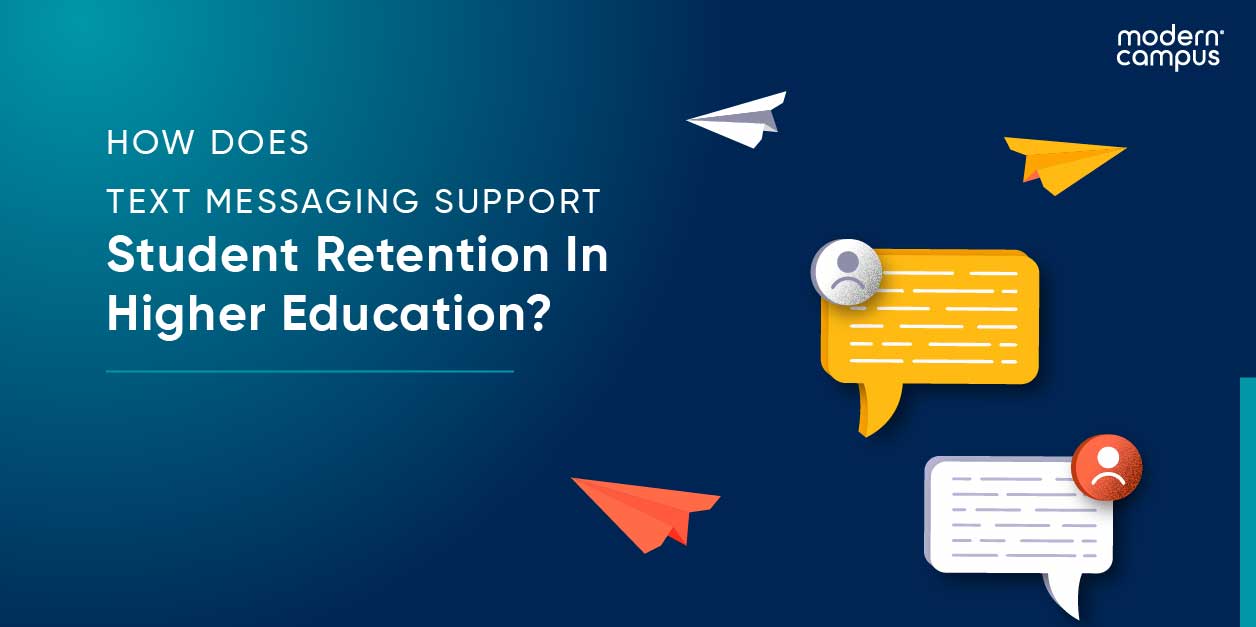5 Ways Conversational Text Messaging Supports Student Retention
Students are complex, and so too, are the challenges they face in staying enrolled.
To boost student success and persistence in your education, you must understand those unique challenges and direct each learner to the right resources.
The key here is finding the right communication channel to support retention in education. Your outreach efforts won’t move the needle on engagement nor increase student retention if your recipients don’t read, engage with and learn from your messaging. The great majority of students no longer read the majority of their email messages. Email averages just a 20% open rate. In other words, if you rely on email alone, only one in five students will read your messages. Worse yet, only one in twenty students will respond.
Benefits of texting for student engagement
Texting is a whole different story. More than 96% of American adults own a smartphone, and 98% of text messages get read.
Many colleges and universities have seen success in using text messaging to connect with learners and advance their student retention strategies, including:
- Pellissippi State Community College engaged 86.7% of students in text messages containing academic success tips. Students who participate in the text messaging program have higher GPAs than their non-participating peers by an average of .27 points after one semester of the program.
- By texting students reminders learners about financial aid deadlines, upcoming workshops, and tips on money management, The Austin Community College District increased persistence among part-time students by 15%.
Brigham Young University is taking aim at increasing retention through its peer mentorship program, driven by older students texting first-year learners.
Best practices for using texting to improve student retention
The most effective text messages aren’t generic. Researchers found that text recipients are 75% more likely to engage with companies when communication is personalized. Personalization can include using the student’s name, inviting them to an event that’s designed for their major or year, or sharing a deadline that’s specific to their financial aid status.
By keeping your texts relevant and timely to each individual recipient, your learners are more likely to view your communication as helpful and relationship-driven. Students will understand that texts are sent to serve them rather than to be a one-way announcement engine.
Take, for example, these two messages.
Impersonal messaging: Get ready: course registration begins soon for most students.
Personalized messaging: Julian, course registration for second-year business majors like you opens in 4 days—Tuesday 5/21 at 9 am. Here’s the link to register [link].
The second message not only provides the student with more helpful information but it’s also more engaging and encouraging. It acknowledges the students as an individual with individual needs.
Fortunately, with the right texting platform, personalizing your text messages at scale is a breeze—even easier than an email mail merge. Modern Campus Message integrates with your CRM or SIS data, allows users to segment their audiences, and build targeted communications to ensure their messages hit the right mark at just the right time.
How conversational text messaging supports student retention
Here are four strategies for improving student retention and promoting persistence at higher education institutions.
1. Uncover roadblocks
The power of two-way conversational student text messaging lies in the back-and-forth. Students can reply—at their own time and pace —with questions and concerns.
By asking the right questions, you can uncover a roadblock that may, if left uncleared, prevent a student from persisting. If, for example, a text recipient tells you that they can no longer afford classes, ask why. Perhaps they have new childcare expenses, lost their part-time job or were unprepared for the high costs of textbooks.
Understanding their challenge(s) will allow you to customize your advice and support. For example, rather than merely referring the student to a financial aid advisor, you can direct them to specific forms, suggest a scholarship program or encourage them to apply for a campus job. An example of this process in action comes from Brian Kathman, founder of Modern Campus Message, in writing for Forbes.
“When we know 'the real why,' we can point each student to the resource that best supports them. One of the more interesting exchanges that I have heard was with a student who wasn’t coming back for money reasons. But when told to 'tell me more,' she said, 'I lost my car insurance, and I can’t make it to campus.' The advisor followed up with, 'You are eligible to take classes online,' and the student responded, 'I don’t think my financial aid covers online classes.' The advisor was able to clarify the heart of the matter: 'Yes, online classes are covered by financial aid, and I can help you get registered, and we can figure out how to get you supported.'
The exchange Kathman recaps were done all through texting and took less than 20 minutes! Without it, the students may not have stayed enrolled.
2. Remind students to complete important tasks
No one likes nagging. Whether it’s through email or text, a long message demanding a student complete a dozen tasks is more likely to lead to an eye roll than a response.
That’s why you should trade nagging for nudging. As a communications term, nudging is broadly defined as “coaxing or gently encouraging someone to do something.” In higher ed, nudging helps students move through their journey within a college or university.
With texting, you can gently guide a student to complete a single task and, once they’ve confirmed completion, nudge them toward the appropriate next step. It’s a smart way to avoid writing a dreaded 20-point checklist email.
And nudging gets results. In research on reducing Summer Melt, an overwhelming majority of students who received texts (86%) said that texts had prompted them to successfully complete a task.
3. Build relationships
Students are more likely to use campus support services when they already know and trusts the office’s staff.
Texting can create such knowledge and trust, while increasing students' sense of community. By building relationships over text, you can help students feel comfortable — and even excited —to stop by your office, attend events you host and interact in other meaningful ways.
Texting is a savvy way to extend your reach and warm students up to your services, without having to stop by every residence hall or call every commuter student. It offers a better, easy student experience.
Consider this: would you prefer to attend an event hosted by The Office of Who Knows What, or one planned by Stephanie, the friendly advisor you’ve gotten to know right from your phone? We bet you and your students would pick the latter.
4. Encourage engagement
As we previously explored, participation in co-curricular experiences can hugely benefit student retention rates.
Hartford Community College found that students who attend campus co-curricular events are 53.7% more likely to persist through to the next academic year than their non-engaged peers. Plus, first-year Arkansas Tech University students who record at least one hour of community or volunteer service have a 94% retention rate — 22 percentage points higher than their peers who didn’t record any such hours.
Texting can help you amplify upcoming engagement opportunities and, thereby improve student retention in higher education. You can instantly send texts to thousands of your students about upcoming events, segmented by demographic to ensure relevancy. Additionally, you can guide students through the process of registering a new student organization, enhancing their co-curricular transcript or voting in a Student Government Association election. You can also answer common — or not-so-common — questions about intramural sports, first-year programming or alternative spring break.
With texting, you can engage students and parents who might not respond to emails, take note of campus fliers or reply to social media events.
Ready to design your own texting campaign?
Check out our free guide. You'll find advice on scheduling your texts and designing a texting cadence, along with example messages.
Last updated: June 19, 2023




